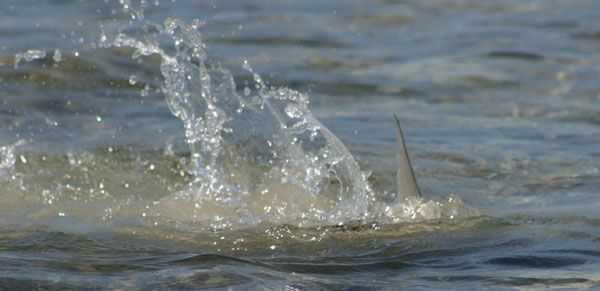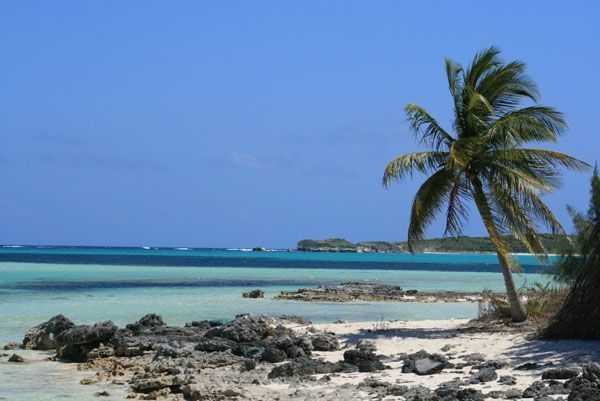Looking to avoid winter’s chill, I sought refuge and Bonefish on San Salvador Island Bahamas, a sixty square-mile limestone deposit lying on the eastern rim of the Atlantic Ocean.
Surrounded by thousand foot abysses, only a handful of shallow water flats and one pristine creek provides suitable bonefish habitat along the rocky shores of San Sal, noted for its spectacular wall diving and wahoo fishing. But, in addition to fishing, I was looking for solitude, and the friendly family island with a population of eight hundred was just the ticket.
My sojourn would be a low budget affair with extra cash for fishing guides not practical. Budgetary restraints would preclude transportation except for foot and thumb as well. As my cousin the undertaker would say, “If this was a funeral, it would be a fast driving, shallow digging, no singing affair.”
I hitched to Russell’s store in Cockburn Town, across from a two hundred year old Almond tree dominating the intersection, a protective canopy for the settlement’s hub of actively. On a shaded bench at the roads edge, the island’s official troubadour Pop, sat drinking a coke soda, his ever-present left hand strung guitar by his side.
Pop, approaching seventy, is a regular at the San Sal airport and Riding Rock Marina serenading arrivals from Canada, Europe, and the U.S. with his raspy voiced repartee of island melodies.
An authority on the shallower waters of the Island, Pop spends off hour hand lining small snapper and grouper off rock formations and in deep holes reachable from shore. He targets Bonefish in the deeper dredged channels of Riding Rock Marina and Government Cut. To Pop, as with many Bahamians, Bonefish are highly prized table fare.
“Did you catch any fish today?” I ask, looking for an icebreaker to start the conversation.
“Naw, I couldn’t get no con fish.” Pop replies, referring to small baitfish he uses to con the larger Grouper and Snapper into biting.
When I emerge from the small island store with an extra can of corn beef and present it to the bearded balladeer, an information conduit is established.
Following Pop’s directions, I gathered my gear and set off to explore the closest X marked on my satellite photo, French Bay.
Falling in love with a fishing-hole is as old as the hook. Even before unsheathing my Thomas and Thomas nine-weight, or seeing my first tail, the wild beauty of French Bay seized me. Rolling breakers from an Atlantic swell curled on rocks a half-mile from shore, launching a soft crescendo of ocean sound that bathed the isolated cove. Only the squawks of the resident osprey, protesting the intrusion, and the shrill call of the Kingfisher broke the soft thunder of the waves.
At low tide, vast expanses of water carved rock, backed by lush mangrove lay exposed, broadening at the entrance to a small tidal creek, a mile farther down. Beyond the creek a pearl sand beach stretched another two miles, ending abruptly at the white limestone bluffs of Sandy Point.
Adding drawing power, the creek halfway down is a Conch nursery, a natural baby conch farm, and the Bones loved them.
My most memorable day at French Bay occurred on a most unlikely excursion in less than perfect conditions.
Billowy clouds moved in and the rising wind built to twenty knots, the normally calm water chopped by remnant waves fetching over the reef on the high tide. I made straight for the nursery hardly scanning the flat rock muddy shallows leading to the cove.
I spotted the tails waving along the mangroves, the largest tailing bones I’d ever seen. Easing closer, I took cover behind a solitary mangrove precariously rooted to the rocky point outside the cove and watched the fish working tight against the roots.
These fish were feeding voraciously, heads down, tails at times completely above the water, forcing the mudding fish’s mouths deeper into the sand. From time to time scattered splotches of sunlight swept across the cove and in the swift moving shafts of light, I made out the small group of nine to twelve pound fish, all trophies.
This school I had seen before, but they were smart, spooky, always on the move. Now I had them cornered and distracted with the wind a double-edged sword. On one hand it would hinder casting, but it was noisy and together with the cloud-cover restricted vision between the mediums of air and water.
Choosing a heavier crab pattern to counteract the puffing breeze, my first cast landed much too close to two tailing fish. Not deterred in the slightest, the larger of the two pounced on my offering in a mad fit of feeding. I striped set the hook and the fish blazed out of the cove, skirted the mangrove bush, headed to open water. Within seconds the reel was down to half the backing as the fish streaked across the rocky flat and into deeper pot holed bottom. Rod held high, wading and winding as fast as humanly possible, I made it to the edge before the fish took off on another drag burning run. Before the fight concluded he would have three more burst well into the backing until in a tired and somewhat confused state of mind, he ran aground.
Largest bonefish of my life, somewhere around twelve pounds and no one to witness or take a snapshot.
Although no photo or eye witness account of the banner bonefish exits, the image is etched in my mind, cemented in the solitude of the moment and can be revisited instantly, by simply closing my lids and drifting back to French Bay.
[easy-social-share]


